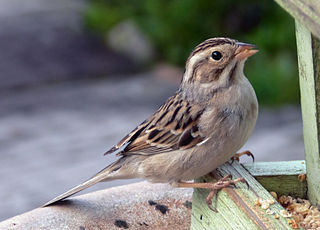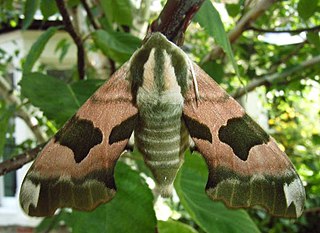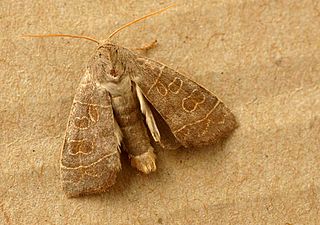Related Research Articles

The clay-colored sparrow or clay-coloured sparrow is a small New World sparrow of North America.

Mimas tiliae, the lime hawk-moth, is a moth of the family Sphingidae. It is found throughout the Palearctic region and the Near East, and has also been identified in eastern Canada. The species was first described by Carl Linnaeus in his 1758 10th edition of Systema Naturae.

Cerapteryx graminis, the antler moth, is a moth of the family Noctuidae. It is a common species throughout most of Europe but is lacking in the very dry southern regions. The northernmost occurrence is Iceland, and above the Arctic circle. It also occurs in Siberia and in North Mongolia. The species has been introduced to North America. In the Alps it rises to an altitude of 2100 meters.

Apamea sordens, the rustic shoulder-knot or bordered apamea, is a moth of the family Noctuidae. The species was first described by Johann Siegfried Hufnagel in 1766. It is distributed throughout Europe, east across the Palearctic to Central Asia and to China and Japan. It also occurs in North America.

Agrochola lota is a species of moth of the family Noctuidae. It is distributed throughout the whole of Europe except Scandinavia; in Armenia, Asia Minor, and East across the Palearctic to the Altai mountains and West Siberia.

Ipimorpha subtusa, the olive, is a moth of the family Noctuidae. It is found in the Palearctic realm.

Anaplectoides prasina is a species of moth of the family Noctuidae. It is found in both the Palearctic and Nearctic realms.

The Green-brindled Crescent(Allophyes oxyacanthae) is a moth of the family Noctuidae. It is found in Europe.

Bityla sericea is a species of moth in the family Noctuidae. This species is endemic to New Zealand. It is classified as "At Risk, Naturally Uncommon" by the New Zealand Department of Conservation.

Hadena perplexa, the tawny shears or pod lover, is a species of moth of the family Noctuidae. It is found in Morocco, Algeria, Tunisia, Europe, Turkey, Israel, Lebanon, Syria, Jordan, Iran, Iraq, northern Asia, Central Asia, northern India and western China.

Lithophane socia, the pale pinion, is a moth of the family Noctuidae. The species was first described by Johann Siegfried Hufnagel in 1766. It is found throughout western Europe from Spain to central Scandinavia then east across the Palearctic to Siberia, the Russian Far East and Japan.

Denticucullus pygmina, the small wainscot, is a moth of the family Noctuidae. It is found in most of Europe, ranging from northern Spain, through Portugal as far north as Finland. In the east it is found across the Palearctic to the Russian Far East and western Siberia. It is also found in North Africa, Turkey, the Caucasus region and northern Iran.

Acrobasis caryae, the hickory shoot borer, is a species of snout moth in the genus Acrobasis. It was described by Augustus Radcliffe Grote in 1881, and is known from southeastern Ontario, Canada, and the eastern United States.
Baphala is a genus of snout moths. It was described by Carl Heinrich in 1956.
Baphala eremiella is a species of snout moth in the genus Baphala. It was described by Harrison Gray Dyar Jr. in 1910, and is found in the US state of California.
Baphala glabrella is a species of snout moth in the genus Baphala. It was described by Harrison Gray Dyar Jr. in 1919, and is found in Guatemala.
Baphala goyensis is a species of snout moth in the genus Baphala. It was described by Ragonot in 1901, and is found in south-eastern Brazil, Uruguay and Argentina.
Baphala homoeosomella is a species of snout moth in the genus Baphala. It was described by Zeller in 1881, and is found in Cuba, the Virgin Islands, Panama, Guyana, Colombia and Brazil.
Baphala phaeolella is a species of snout moth in the genus Baphala. It was described by Herbert H. Neunzig in 1997 and is found in North America, including Maryland, Mississippi and West Virginia.

Parastichtis suspecta, the suspected, is a species of moth in the family Noctuidae. It is found from most of Europe through Russia and east through the Palearctic to Japan. It is also found in North America.
References
| This Phycitinae-related article is a stub. You can help Wikipedia by expanding it. |